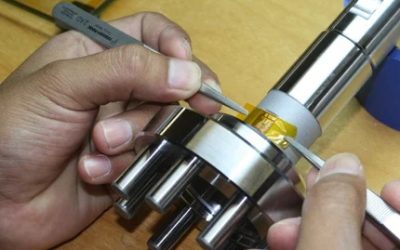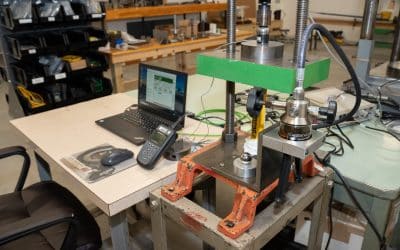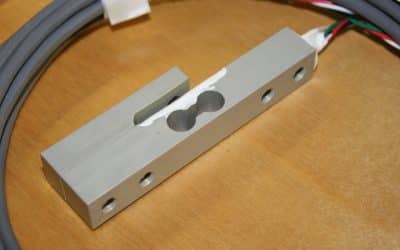Torque Sensor & Load Cell Calibration
Industry Insights
Torque Sensor & Load Cell Calibration
Like all measurement instruments, load cells and torque sensors are subject to aging. Mechanical stress and fatigue experienced through normal use will cause sensors to “drift” over time. Although this instability cannot be prevented, it can be identified and corrected by a well designed calibration program.
The Torque Sensor and Load Cell Calibration Process
Load cells and torque sensors are calibrated by applying a series of known loads from zero to full scale (F.S.) capacity, and recording the output of the sensor. Care is taken to choose an adequate number of verification loads, throughout the entire measuring range of the sensor. Typically 5-15 measurements are taken per verification run, and often determined by an industry standard, such as ASTM E74.
Loads are usually applied in ascending increments, but depending on how the sensor is used in service, it could be calibrated in descending increments, or both ascending and descending. Multiple verification runs are completed to determine the repeatability of the sensor.
Calibrations determine the overall performance of the sensor, often including:
- Combined Error or Static Error Band
- Non-linearity
- Non-Return to Zero
- Non-Repeatability
- Hysteresis Error
How often should load and torque sensors be calibrated?
A common industry recommendation is to calibrate load cells and torque sensors on an annual basis. This provides a reasonable and reliable assurance program that is adequate for most applications. However, there are a lot of factors that go into determining an appropriate calibration cycle. For certain applications, it may be appropriate to calibrate more or less frequently than 1 year.
To determine an appropriate calibration interval, it is important to consider:
- The acceptable accuracy & uncertainty for your application.
- The frequency of use, and typical ‘wear & tear’ of the instrument.
- The stability of the sensor, is determined through previous calibrations, or manufacturer specifications.
In order to have confidence in your measurements, it is recommended to implement spot checks on your instruments between calibration cycles. This could include:
- Comparisons to other calibrated instruments
- Retesting of retained items to study trends
- Use of check standards with control charts
- Shunt calibrations and/or bridge resistance checks
As with any measuring instrument, any suspected damage to the load cell or torque sensor is cause for immediate calibration prior to being put back into service.
Do I need to get load cell / torque sensor calibration done by a professional?
While the calibration process is not overly complicated, it requires experience, mechanical and electronic equipment, and practice to produce consistent, accurate results.
What to consider when determining if you should calibrate yourself:
Reference Standards: Performing force and torque calibrations requires highly accurate reference standards (precision load cells, test weights, indicators, etc.). These reference standards must also be calibrated at an appropriate interval.
Loading Equipment: Calibration of load cells and torque sensors requires the use of expensive loading fixtures, jacks, torque lever arms, etc.
Data Calculation & Analysis Software: Most calibration providers use custom software and macros to quickly analyze calibration data to determine errors, accuracy, uncertainties, and acceptance. While it is not impossible, manually analyzing calibration data can be tedious, time consuming, and prone to errors.
Measurement Assurance: Most calibration providers have rigorous measurement assurance programs to ensure the validity of results. Having your sensors calibrated by a knowledgeable and reputable source provides validation of your measurement system.
Independent Third Party Accreditation: The benefits of ISO 17025 accreditation are detailed below.
Cost: Ultimately, when weighing the items listed above, the determination of whether to calibrate your sensors in-house comes down to cost. Is the investment in equipment, resources, and time worthwhile?
A professional calibration provider must invest heavily in equipment, software, and training to provide highly accurate and efficient calibrations. The investment required to perform calibrations in-house is likely significantly higher than the cost to pay a calibration provider to do it for you. Additionally, calibrating equipment yourself may not be as reliable or accurate.
What is ISO 17025 accreditation?
ISO 17025 is an international standard that establishes requirements for laboratories to enable them to demonstrate they operate competently, and are able to generate valid results. A laboratory must be accredited by an independent accreditation body, recognized by the International Laboratory Accreditation Cooperation (ILAC). Accreditation assessments are performed by the accreditation body to verify the lab’s compliance with ISO 17025 requirements.
There are multiple benefits to working through a 17025 accredited calibration lab:
- Independent verification by third party agencies to ensure compliance.
- Verification of traceability to a National Metrology Institute (NMI), such as NIST.
- Measurement uncertainty for each step in the traceability chain, calculated according to defined methods, such that uncertainty for the whole chain may be calculated or estimated.
- Technical competence of calibration staff.
- Validity and appropriateness of test methods.
- Participation in proficiency testing and inter-laboratory comparisons to monitor performance.
- Measurement assurance programs and maintenance of test equipment to ensure validity of results.
Conclusion
Annual load cell and torque sensor calibration is necessary for equipment across many industries. While it is possible to calibrate some sensors manually, it is usually worth the investment to have a professional do it. Professional calibration labs with ISO 17025 accreditation are able to provide competent and valid results.
Sensing Systems is able to quickly calibrate any load cell or torque sensor for any application. If you are in need of sensor calibration, feel free to contact us. We’re happy to answer your questions and recommend a calibration process that meets your needs for reliability and accuracy.
Industry Insights
Environmental Factors That Affect Strain Gauge Performance — and How to Protect Your Measurements
Strain gauges are extremely useful for precise stress and strain...
The Importance of Calibration in Long-Term Sensor Performance
Precision sensors such as load cells, torque sensors, and strain gauges...
Load Cell vs. Pressure Transducer: Understanding the Difference
When it comes to measuring force, weight, or pressure, two of the most...



